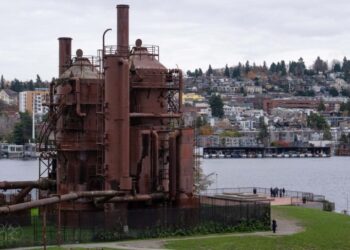Deep inside a Colorado mountain lurks a remnant of the Cold War era.
Buried 2,000 feet beneath Cheyenne Mountain is a secret military complex, where 15 buildings can seal themselves off from the rest of the world within seconds in the event of a nuclear blast.
The complex is said to be designed to withstand a 30-megaton nuclear blast, per the Guardian, which is about 2,000 times as strong as the 15-kiloton bomb that was dropped on Hiroshima.
Construction on the complex, which is located about 10 miles from downtown Colorado Springs, began in 1961.
Today, the secretive underground complex remains functional as a backup command center for the North American Aerospace Defense Command (NORAD), a US-Canada binational organization that provides aerospace warning and control over North America, and the US Northern Command (USNORTHCOM).
Take a look inside.
The Cheyenne Mountain Complex is buried nearly half a mile deep into a solid granite mountain.
Born out of the perceived need for a hardened command and control center in the US amid the height of the Cold War, the Cheyenne Mountain Complex was built deep into the Cheyenne Mountain, where solid granite naturally protects operations from outside threats.
The complex cost $142.4 million to build in the 1960s, or over $1.5 billion in today’s money.
The complex cost $142.4 million in 1961, or approximately $1.6 billion in today’s dollars, according to the US Bureau of Labor Statistics. Construction began in 1961.
Over the five years it took to build, the 9,565-foot-high mountain was blasted, and more than 693,000 tons of granite were excavated to make way for the operations center.
The facility became fully operational in 1966 as NORAD‘s Combat Operations Center.
During the Cold War, the complex continuously tracked potential Soviet missiles, bombers, or spacecraft.
Throughout the following decades, the Cheyenne Mountain Complex housed operations for NORAD, the US Northern Command, the US Strategic Command, and the US Air Force Space Command.
Officers inside the mountain worked around the clock to track potential Soviet missile, bomber, and spacecraft launches.
Today, the center is still functional as a backup and training site.
While the core of NORAD’s operations moved to the nearby Peterson Space Force Base in 2006, the Cheyenne Mountain Complex has remained operational as a backup and training facility.
Today, the complex is owned and operated by the US Space Force, with NORAD and USNORTHCOM using only 30% of the complex’s floor space and accounting for 5% of the daily population inside the mountain, according to the US Northern Command.
The mountain complex is entirely self-sufficient.
The complex spans over 5 acres inside the mountain across 15 underground buildings, and is entirely self-sufficient.
With over 6 million gallons of water stored in carved granite pools and 510,000 gallons of diesel, as well as efficient food storage and thorough air filtration systems, the complex is equipped to operate for weeks on end when sealed off from the outside world.
The complex is built to endure nuclear, electromagnetic, cyber, and biological attacks.
The Cheyenne Mountain Complex was built to survive nuclear attacks, but its facilities can also withstand electromagnetic bombs or solar destruction, chemical and biological attacks, and cyberterrorism.
Two 3-feet-thick, 23-ton blast doors seal off the complex from the outside world.
In the case of a threatening emergency, the complex is sealed off from the outside world in about 20 seconds by its 23-ton blast doors, which are 3 feet thick and built to endure nuclear shock waves in the case of a nearby explosion.
The doors, which are open during regular operations, will regularly close for drills.
The last time they closed outside drills was during the September 11 attacks in 2001, Wired reported in 2017.
The complex’s buildings are mounted on earthquake-resistant springs.
The 15 buildings are mounted atop over 1,300 steel coils designed to absorb seismic shocks in the event of an earthquake or nuclear blast.
The springs hold the buildings 18 inches above the mountain’s rock base to ensure the safety of staff and equipment, per the US Space Force.
Inside the buildings, pipes are bendy to avoid bursts during potential ground movements, per Wired.
The complex is also home to the world’s “most secure Subway.”
Between 350 and 580 people work inside the complex every day, the Air & Space Forces Magazine reported in 2016.
The mountain complex also houses medical and other facilities for staff to use daily and in case of a “button-down scenario,” an emergency where the complex closes its doors.
The facilities include a regular clinic, a dentist, a self-checkout convenience store, and a chapel with a nondenominational chaplain.
The gym inside the facility, which transforms into a hospital in the case of an emergency, has regularly scheduled spin classes for those working inside the base.
A Subway located inside the complex, which feeds staff on a daily basis, prides itself on being the world’s “most secure Subway” location, per Wired’s reporting.
Today, government officials at the complex monitor the skies for nuclear threats.
Today, government officials working from the mountain complex monitor the skies for evidence of missiles or spacecraft launches, nuclear tests, and suspicious space behavior, among other concerns.
The command center also provides backup operations and training for NORAD and USNORTHCOM staff.
To keep communications within the center secure, no electronics connect to outside networks — which are also impossible to reach through the granite mountain — and officials use Defensive Cyber Operations to detect and stop attempts to infiltrate inside networks, Wired reported.
If the main NORAD and USNORTHCOM command post goes offline, the mountain complex can take over anytime.
Aside from providing support and training to the Peterson Space Force Base operations, the Cheyenne Mountain Complex is also equipped to take over as a command center for NORAD and US Northern Command if the main command at the base goes offline during an emergency.
Inside, employees are often reminded of where they are and what they do.
Signs like the one above remind employees inside the mountain center that power and personnel are what keep the operations running.
In the case of an emergency, staffers would be sheltered in the complex, but their families or others on the outside wouldn’t be allowed entry, a sacrifice that many of them keep in mind often.
In the Wired story, an officer told the reporter that in the case of an emergency, he told his family: “I’m going to be in the mountain doing my job… and I can’t help you.”
Employees at the complex regularly have “sleepover” drills where they practice leaving their world behind.
The complex is home to confidential communications … but also harmless jokes.
Aside from the inherent heaviness of working inside a mountain bunker built to outlast nuclear destruction, staff pass their days doing their jobs and even keeping inside jokes alive, like the stuffed alien doll that staffers keep on the director’s desk.
Read the original article on Business Insider
The post A Cold War nuclear bunker is buried deep inside a Colorado mountain. See inside the Cheyenne Mountain Complex. appeared first on Business Insider.




